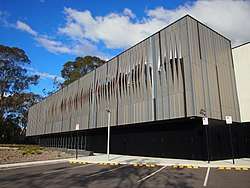National Computational Infrastructure
The National Computational Infrastructure (also known as NCI or NCI Australia) is a high-performance computing and data services facility, located at the Australian National University in Canberra, Australian Capital Territory. The NCI is supported by the Australian Government's National Collaborative Research Infrastructure Strategy (NCRIS), with operational funding provided through a formal collaboration incorporating CSIRO, the Bureau of Meteorology, The Australian National University, Geoscience Australia, the Australian Research Council, and a number of research intensive universities and medical research institutes.

The current director is Professor Sean Smith.
Computer systems
As of June 2020, NCI operates two main high-performance computing installations, including:
- Gadi, a 9.26 PetaFLOP high-performance distributed memory cluster consisting of:
- 145,152 cores (Intel Xeon Scalable 'Cascade Lake' processors) across 3024 nodes
- 160 nodes containing four Nvidia V100 GPUs
- 567 Terabytes of main memory
- 20 Petabytes of fast storage
- 47 Petabytes of storage for large data files
- 50 Petabytes of tape storage for archival
- HDR Mellanox Infiniband in Dragonfly+ topology (up to 200Gbit/s transfer)
- Tenjin, a 67 TeraFLOP bespoke high-performance partner cloud, consisting of:
- 1600 Intel Xeon Sandy Bridge cores
- 25 Terabytes main memory
- 160 Terabytes State Disk
Data services and storage
NCI operates the fastest filesystems in the Southern Hemisphere. 20 Petabytes of storage is available for fast I/O, 47 Petabytes is available for large data and research files, and 50 Petabytes is available on tape for archival.
Research
Research conducted or under way includes:[1]
- Southern Sky Survey, using the ANU's robotic SkyMapper telescope at Mount Stromlo Observatory
- The Australian Community Climate and Earth System Simulator (ACCESS)
- COVID-19 mitigation research
- Medical and materials research
History
NCI Australia is a direct descendant of the ANU Supercomputing Facility ANUSF, which existed from 1987 through to 1999. At the turn of the new millennium, the Australian Government pushed ahead with a process to form the Australian Partnership for Advanced Computing (APAC), the foundation of which would be built around a new national computational infrastructure. With its heritage in supercomputing, it was decided that the APAC National Facility would be located at The Australian National University, with the facility ultimately commissioned in 2001.
In 2007, APAC began its evolution into the present NCI collaboration.
The below table is a comprehensive history of supercomputer specifications present at the NCI and its antecedents.
| System (name) | Processor | Memory | Storage | Peak Perf. | Sustained Perf. (SPEC) | Initial
Top500 Rank |
| 1987–92
Fujitsu VP100 |
Vector | 64 MByte | 0.15 GFlops | |||
| 1992–96
Fujitsu VP2200 |
Vector | 512 MByte | 27 GByte | 1.25 GFlops | ||
| 1996–2001
Fujitsu VPP |
Vector/
Scalar |
14 GByte | 28 GFlops | 59 | ||
| SGI Power Challenge XL | 20
MIPS R10000 |
2 GByte | 77 GByte | 6.4 GFlops | ||
| 2001–05
Compaq/HP Alphaserver (sc) |
512
DEC Alpha |
0.5 TByte | 12TByte | 1 TFlop | 2,000 | 31 |
| 2005–09
SGI Altix 3700 (ac) |
1920
Intel Itanium |
5.5 TByte | 100 TByte | 14 TFlop | 21,000 | 26 |
| 2009–13
SGI Altix XE (xe) |
1248
Intel Xeon (Nehalem) |
2.5 TByte | 90 TByte | 14 TFlop | 12,000 | — |
| 2009–13
Sun/Oracle Constellation (Vayu) |
11,936
Intel Xeon (Nehalem) |
37 TByte | 800 TByte | 140 TFlop | 240,000 | 35 |
| 2013–2019
Fujitsu Primergy (Raijin) |
57,472
Intel Xeon (Sandy Bridge) |
160 TByte | 12.5 PByte | 1195 TFlop | 1,600,000 | 24 |
| 2020–Present
Fujitsu Primergy CX2570 (Gadi) |
145152
Intel Xeon (Cascade Lake) |
576 TByte | 20 PByte | 9260 TFlop | 24 |
See also
References
- "Research Highlights - National Computational Infrastructure". National Computational Infrastructure. Retrieved 25 June 2020.